Bonding - Covalent Bonds (A-Level Chemistry)
Covalent Bonds
Covalent Bonding
Single Covalent Bonds
- A covalent bond is the bond formed between atoms that share electrons. Atoms share electrons to gain a full outer shell of electrons. Remember that they want to gain a full outer shell as this is when the atom is most stable and inert.
- A single covalent bond contains a shared pair of electrons. Each covalent bond involves two electrons which makes up the shared pair of electrons. Each electron from the electron pair comes from each of the atoms involved in the covalent bond.
- A molecule is made up of two or more atoms. When two or more atoms join together a molecule is made. E.g. two oxygen atoms form the O2 (oxygen) molecule. Four hydrogen atoms and a carbon atom make the CH4 (methane) molecule.
- A covalent bond forms between atoms that are non-metals. The main form of bonding between non-metals is covalent bonds where non-metals share electrons in a bond.
- The electrostatic attraction between the nuclei and the shared electrons maintain the covalent bond. The nucleus has an overall positive charge because it contains protons which have a positive charge and neutrons which have a neutral charge. This means that there is an electrostatic attraction between the positively charged nuclei and the negatively charged electrons. The electrostatic attraction holds the two atoms in the covalent bond together.
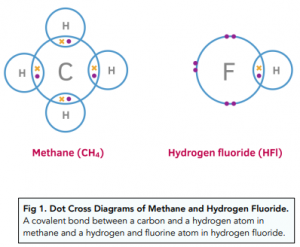
This figure shows what a covalent bond looks like between a carbon atom and a hydrogen atom in methane as well as a hydrogen and fluorine atom in hydrogen fluoride. There are two electrons in each covalent bond where each is represented by either a dot or a cross. Atomic orbitals of each atom involved in the covalent bond overlap so that each of them contributes one electron each to the covalent bond.
Multiple Covalent Bonds
- Atoms can form multiple covalent bonds as well has single covalent bonds. A multiple covalent bond can be either a double or triple covalent bond and it is when atoms share several pairs of electrons rather than just a single pair.
- A double covalent bond is when atoms share two pairs of electrons. E.g. the covalent bond between two oxygen atoms involves sharing two pairs of electrons to gain a full outer shell.
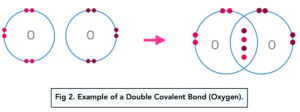
- A triple covalent bond is when atoms share three pairs of electrons. E.g. the covalent bond between two nitrogen atom involves sharing three pairs of electrons to gain a full outer shell.
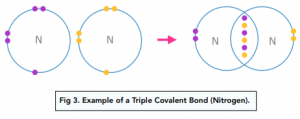
Dative Covalent Bonding
- A dative covalent bond contains a shared pair of electrons donated by one atom only. In a dative covalent bond both electrons in the electron pair come from one atom in the bond.
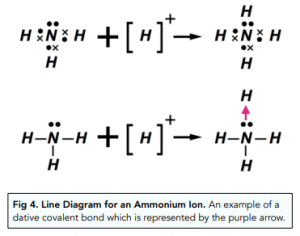
This figure represents an example of a dative covalent bond which is represented by the arrow. The head of the arrow touches the atom receiving the donated electron and away from the donor atom. The donated pair of electrons are represented by two dots. Each line represents a covalent bond.
Another example of a compound with dative bonds you need to know about is Al2Cl6, which forms as a result of the formation of two dative bonds between two AlCl3 molecules.
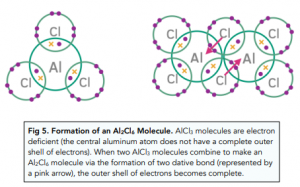
Bond Energies
Bond energy is the energy required to break one mole of a particular covalent bond in gaseous state.
Bond energy depends on bond length: the distance between the nuclei of two covalently bonded atoms. The shorter the bond length, the stronger the bond and hence the more the energy required to break it.
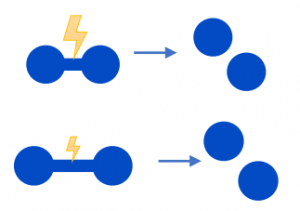
Bond energy can be used as a measure of how reactive a covalent compound is. The lower the bond energy, the easier to break the covalent bonds between the atoms in the compound will be and hence the more readily will the compound react.
Covalent Bonding and Atomic Orbitals
When a covalent bond forms two atomic orbitals from two different atoms, each containing one electron, overlap to form a combined molecular orbital containing two electrons that then spreads over the two atoms involved in the bond.
Covalent bonds can be classified according to the type of overlap undergone by atomic orbitals. The types of covalent bonds that can form are:
- Sigma (σ) bonds – form as a result of the heads-on overlap of atomic orbitals. The resulting molecular orbital is symmetrical with respect to the internuclear axis. Sigma bonds always are single bonds.
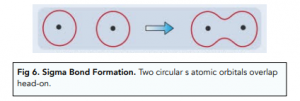
- Pi (π) bonds – form as a result of the side-ways overlap of hourglassed-shaped p atomic orbitals. The overlapping region exists above and below the internuclear axis between the two atoms. Pi bonds are weaker than sigma bonds because there is less overlap. Pi bonds can only be found in multiple covalent bonds: the first covalent bond will be a sigma bond and any bonds that form thereafter will be pi bonds.
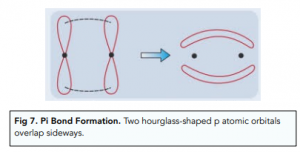
Bond hybridisation
Bond hybridisation is the process by which atomic orbitals in the same energy level mix together to form new (hybrid) orbitals that are able to form covalent bonds.
To better understand this process we will look at carbon as an example.
Example: Carbon in Methane
The electron configuration of carbon is 1s2 2s2 2p2. To form methane (CH4), the central carbon atom needs to make 4 bonds and hence would need 4 unpaired electrons. However, only the two unpaired electrons in the 2p orbital are available to make a bond each.
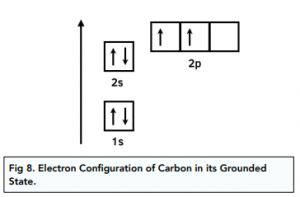
In order to work around this, the carbon atom enters an excited state in which some of its electrons get more energy and are promoted to higher energy levels.
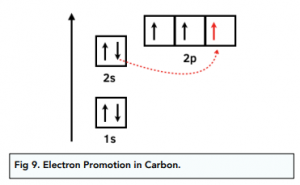
The atomic orbitals in which they exist merge together to form new hybrid orbitals. As the hybridization involves one s orbital and three p orbitals, the resulting hybrid orbitals are referred to as sp3 orbitals.
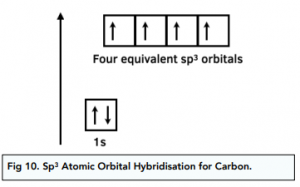
When n number of atomic orbitals merge, n number of hybrid orbitals form so here we get 4 sp3 orbitals.
The electrons can now arrange themselves in these new hybrid orbitals so that each one of them contains one unpaired electrons and can form covalent bonds.
Working out orbital hybridisation
Sigma bonds are formed by the overlap of hybridised atomic orbitals.
Pi bonds are formed by the overlap of left over non-hybridised p atomic orbitals.
Lone pairs of electrons are fully hybridized orbitals.
In order to find the total number of hybridized orbitals that an atomic a compound has, we have to count the number of single and multiple covalent bonds it forms and the number of lone pair of electrons it has.
Practice question: Figure out the hybridisation pattern of one of the carbon atoms in ethene.
1. Find the relevant atom within the molecule and count the number of covalent bonds it forms and the number of lone pairs of electrons.
The carbon atom in ethane forms: 2 single covalent bonds with hydrogen atoms and one double covalent bond with the other carbon atom in the molecule. It has no lone pairs of electrons.

2. Figure out how many sigma and pi bonds the atom forms.
The two single covalent bonds will be sigma bonds. Within the double covalent bond we will have a sigma bond and a pi bond.
Therefore we have 3 sigma bonds and one pi bond per carbon atom.
3. Figure out the number of hybridized orbitals the atom needs.
Only sigma bonds form from hybridised orbitals. Lone pairs would also involve hybridised orbitals but in this example there are no lone pairs so it isn’t applicable.
Therefore we need 3 hybridised orbitals.
4. Figure out the type of hybridised orbitals that form.
Remember that when n number of atomic orbitals merge, n number of hybrid orbitals form. If we need 3 hybrid atomic orbitals we need 3 atomic orbitals to merge.
The resulting hybrid orbitals will therefore be sp2 hybrid orbitals. If we look back at Fig. 5, the 2s orbital will merge with two of the 2p orbitals.The remaining unhybridised p orbital will be available to form the pi bond in the double covalent bond.
FAQs
In A-Level Chemistry, a bond refers to the force of attraction between two or more atoms that holds them together in a stable structure.
A covalent bond is a type of chemical bond in which atoms share electrons in order to form a stable bond. Covalent bonds are formed between non-metallic elements, such as hydrogen, oxygen, nitrogen, and carbon.
The difference between a covalent bond and an ionic bond is that in a covalent bond, electrons are shared between atoms, whereas in an ionic bond, electrons are transferred from one atom to another. Covalent bonds are typically formed between non-metallic elements, while ionic bonds are typically formed between a metallic element and a non-metallic element.
Covalent bonds affect the physical properties of a molecule because they determine the shape of the molecule and its strength. The shape of a molecule affects its reactivity and its ability to form other bonds. The strength of a covalent bond determines the stability of the molecule and its ability to withstand physical and chemical stress.
Yes, covalent bonds can be broken or reformed. Covalent bonds can be broken by chemical reactions, such as combustion or oxidation, or by physical processes, such as heating or cooling. They can also be reformed through chemical reactions, such as the formation of new molecules from individual atoms.
Covalent bonds play a crucial role in the structure of organic molecules. They form the backbone of the molecule and determine its shape, reactivity, and physical properties. Organic molecules are composed of carbon atoms covalently bonded to hydrogen and other elements, such as oxygen and nitrogen. These covalent bonds allow organic molecules to form large and complex structures, such as proteins, carbohydrates, and lipids.
Yes, covalent bonds can be polar or nonpolar. A polar covalent bond is formed when the electrons are not shared equally between the two atoms, resulting in an uneven distribution of electrical charge. A nonpolar covalent bond is formed when the electrons are shared equally, resulting in a neutral distribution of electrical charge. The polarity of a covalent bond affects the physical properties and reactivity of the molecule.





Still got a question? Leave a comment
Leave a comment